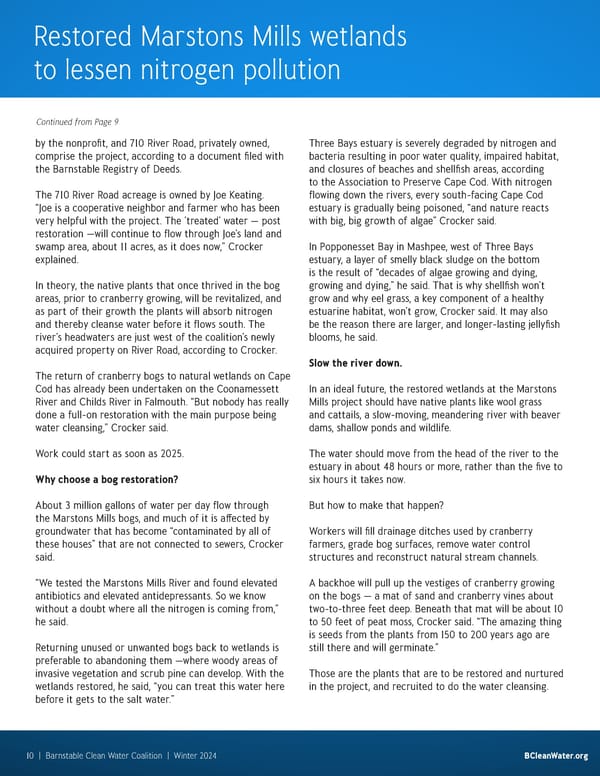Restored Marstons Mills wetlands to lessen nitrogen pollution Continued from Page 9 by the nonpro昀椀t, and 710 River Road, privately owned, Three Bays estuary is severely degraded by nitrogen and comprise the project, according to a document 昀椀led with bacteria resulting in poor water quality, impaired habitat, the Barnstable Registry of Deeds. and closures of beaches and shell昀椀sh areas, according to the Association to Preserve Cape Cod. With nitrogen The 710 River Road acreage is owned by Joe Keating. 昀氀owing down the rivers, every south-facing Cape Cod “Joe is a cooperative neighbor and farmer who has been estuary is gradually being poisoned, “and nature reacts very helpful with the project. The ’treated’ water — post with big, big growth of algae” Crocker said. restoration —will continue to 昀氀ow through Joe’s land and swamp area, about 11 acres, as it does now,” Crocker In Popponesset Bay in Mashpee, west of Three Bays explained. estuary, a layer of smelly black sludge on the bottom is the result of “decades of algae growing and dying, In theory, the native plants that once thrived in the bog growing and dying,” he said. That is why shell昀椀sh won’t areas, prior to cranberry growing, will be revitalized, and grow and why eel grass, a key component of a healthy as part of their growth the plants will absorb nitrogen estuarine habitat, won’t grow, Crocker said. It may also and thereby cleanse water before it 昀氀ows south. The be the reason there are larger, and longer-lasting jelly昀椀sh river’s headwaters are just west of the coalition’s newly blooms, he said. acquired property on River Road, according to Crocker. Slow the river down. The return of cranberry bogs to natural wetlands on Cape Cod has already been undertaken on the Coonamessett In an ideal future, the restored wetlands at the Marstons River and Childs River in Falmouth. “But nobody has really Mills project should have native plants like wool grass done a full-on restoration with the main purpose being and cattails, a slow-moving, meandering river with beaver water cleansing,” Crocker said. dams, shallow ponds and wildlife. Work could start as soon as 2025. The water should move from the head of the river to the estuary in about 48 hours or more, rather than the 昀椀ve to Why choose a bog restoration? six hours it takes now. About 3 million gallons of water per day 昀氀ow through But how to make that happen? the Marstons Mills bogs, and much of it is a昀昀ected by groundwater that has become “contaminated by all of Workers will 昀椀ll drainage ditches used by cranberry these houses” that are not connected to sewers, Crocker farmers, grade bog surfaces, remove water control said. structures and reconstruct natural stream channels. “We tested the Marstons Mills River and found elevated A backhoe will pull up the vestiges of cranberry growing antibiotics and elevated antidepressants. So we know on the bogs — a mat of sand and cranberry vines about without a doubt where all the nitrogen is coming from,” two-to-three feet deep. Beneath that mat will be about 10 he said. to 50 feet of peat moss, Crocker said. “The amazing thing is seeds from the plants from 150 to 200 years ago are Returning unused or unwanted bogs back to wetlands is still there and will germinate.” preferable to abandoning them —where woody areas of invasive vegetation and scrub pine can develop. With the Those are the plants that are to be restored and nurtured wetlands restored, he said, “you can treat this water here in the project, and recruited to do the water cleansing. before it gets to the salt water.” 10 | Barnstable Clean Water Coalition | Winter 2024 BCleanWater.org
 BCWC Fall23Winter24 Newsletter Page 9 Page 11
BCWC Fall23Winter24 Newsletter Page 9 Page 11